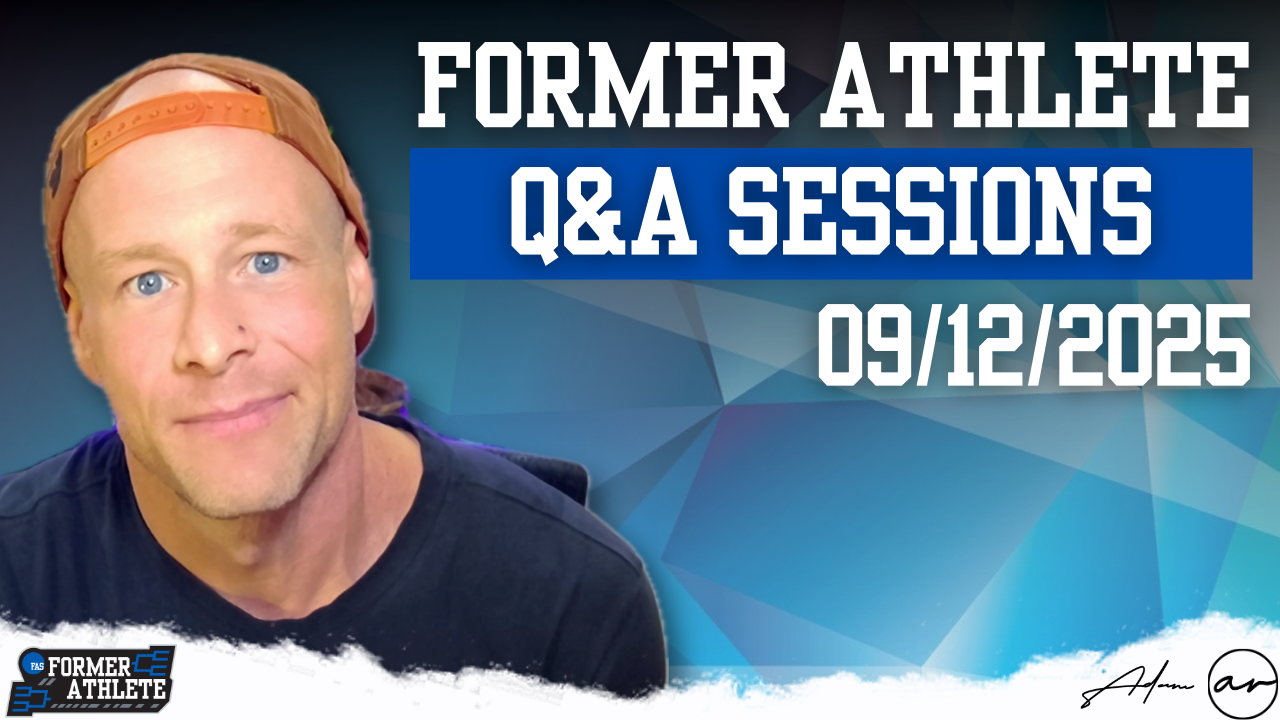Former Athlete Society Q&A — From Energy Drinks to Goal-Aligned Training
In this Former Athlete Society Q&A, we dive into energy drinks and consistency, smart calorie increases, hydration hacks, recovery tools like saunas, and aligning training to match your goals. Practical, no-BS answers to help former athletes level up.

One of my favorite things about the Former Athlete Society is the opportunity to sit down, field your questions, and tackle the topics that actually matter to YOU.
These Q&A sessions are where the real conversations happen—conversations about training, nutrition, recovery, mindset, and everything in between. They’re not scripted, polished lectures; they’re honest, practical exchanges rooted in the lifestyle of former athletes who are still chasing excellence while juggling careers, families, and life’s many responsibilities.
In this latest Q&A session, we covered a wide variety of ground. Some of you wanted clarity on energy drinks and whether they can (or should) play a role in gym consistency. Others asked about increasing calories for muscle building without blowing up body composition. Hydration came up as a topic, especially whether flavored water “counts” toward daily needs. A question about Hotworx and sauna memberships pushed us to look at the difference between helpful recovery tools versus costly distractions. And finally, we dove into the heart of training alignment—why so many of us get pulled in different directions, and how to refocus your programming to actually match the goals you care most about.
This session was a reminder of what makes this community so special: we’re not here for surface-level fitness chatter.
We’re here to cut through the noise, share experiences, and equip one another with strategies that can be applied TODAY. With that said, let’s dive into the five questions that anchored this session.

Here’s what I'm covering...
1. Energy Drinks & Gym Consistency
This first question hit a nerve for a lot of us: “Should I rely on energy drinks to stay consistent in the gym?” It’s an easy trap to fall into. That quick caffeine rush feels like the ticket to overcoming fatigue, stress, or lack of motivation. And hey, we’ve all been there—grabbing the can off the shelf because it feels like the one thing that’ll get you moving.
But here’s the truth: building consistency off the back of energy drinks is like building a house on sand. It might stand for a while, but it’s not sustainable. What really drives consistency is structure—prioritizing sleep, fueling your body with balanced nutrition, creating repeatable habits, and finding a training routine that matches your lifestyle. When you anchor consistency in those fundamentals, energy drinks become optional, not essential. Think of them as a situational tool, not a cornerstone.
At the end of the day, caffeine isn’t the enemy, but dependency is. You don’t want to feel like you can’t train unless you’ve had your fix. Consistency comes from systems, not stimulants.
2. Nutrition for Muscle Building
The next question was about increasing calories for muscle building without losing control of body composition. And this one is deeply relatable because so many athletes—especially those of us transitioning out of competitive seasons—wrestle with the same challenge: how do you add muscle without adding unnecessary fat?
The answer lies in intentionality. Instead of doubling your calories overnight, the goal is slow, steady titration. Increase your intake gradually, monitoring how your body responds week to week. If you see positive strength gains and a slow but steady weight increase, you’re on the right track. If you start adding weight too fast or feeling sluggish, you’ve likely overshot.
The second key is food quality. Anyone can throw back more calories by eating junk, but quality nutrients—lean proteins, complex carbs, and healthy fats—help ensure the additional fuel is actually building tissue instead of being stored away. Pair that with smart programming that prioritizes progressive overload in the gym, and you’ll see those calories turn into muscle rather than unwanted fluff.
3. Hydration Hacks
Another great question was: “Does flavored water count toward hydration?” The short answer is yes. If adding flavor helps you drink more water consistently, then it’s working in your favor. We often overcomplicate hydration, but at the end of the day, what matters most is that your body gets the water it needs.
Now, are there differences between plain water and flavored options with additives? Of course. Some contain sweeteners or sodium, and depending on your personal preferences and health considerations, those may or may not be ideal. But for most people—especially those who simply struggle to drink enough plain water—flavored water is a practical solution. It’s about consistency and compliance.
Here’s the big takeaway: don’t get hung up on perfection. Athletes who perform at a high level don’t stress over whether their hydration came from plain water, flavored water, or even sports drinks. They stress over whether they got enough. So if flavoring helps you hit your daily hydration goals, that’s a win.
4. Recovery Tools (Hotworx & Sauna Memberships)
The fourth question came in about Hotworx and sauna memberships: are they worth it? This is where we have to draw a line between “nice-to-haves” and “essentials.” Saunas, infrared sessions, and recovery studios can provide real benefits—muscle relaxation, improved circulation, stress relief. But they’re secondary tools, not primary solutions.
Here’s what I mean: if your sleep is inconsistent, your training plan is chaotic, or your nutrition is all over the place, a sauna membership isn’t going to move the needle much. Those foundational elements do 90% of the recovery heavy lifting. Saunas, compression boots, and similar recovery modalities fall into the remaining 10%. They’re the cherry on top, not the sundae.
So, should you invest in them? If you enjoy them, have the budget, and already have your fundamentals dialed in, then absolutely—they can add value. But if you’re looking for the most bang for your buck, fix your sleep, fuel well, train smart, and hydrate first. That’s where the real recovery happens.
5. Training Alignment: Matching Your Goals
Finally, we tackled a big-picture question: “How should I modulate my training to match my goals?” This one resonates deeply because many of us live in two worlds. On one hand, we want the lean, aesthetic look of a fitness model. On the other, we want the raw strength of a powerlifter or the conditioning of a CrossFit athlete. The problem? Those goals don’t perfectly overlap.
The key is clarity. If your primary goal is muscular development, then your training should lean toward a bodybuilding-style program with hypertrophy-focused rep ranges, progressive overload, and sufficient volume. If you want raw strength, a powerlifting approach is better. If you crave work capacity, you’ll want something closer to CrossFit or Hyrox. If power and explosiveness are your priority, Olympic lifting is where you should spend time.
The mistake many athletes make is chasing multiple goals simultaneously, which leaves progress diluted across all fronts. The truth is, you can have anything you want, but not everything. Aligning your training with your true goals is about being honest with yourself: What do you want most right now? Once you answer that, your training plan becomes much easier to design and commit to.

All of These Questions were Answered!
During our LIVE YouTube Q&A Session but you MUST be a member to access the exclusive behind the scenes content and information!
Join the Society to WatchClosing Thoughts
This Q&A session reinforced a timeless principle: success is about alignment. Whether it’s energy, nutrition, hydration, recovery, or training goals, everything works better when your habits match your priorities. As former athletes, we know what it feels like to live at a high level, and these conversations are about reclaiming that—on our terms, within our lives today.
If you haven’t yet, check out the full session replay below! And as always, keep sending your questions my way. The Former Athlete Society is only as strong as the community behind it, and these Q&As prove that every single week.
